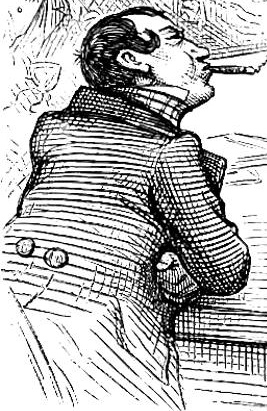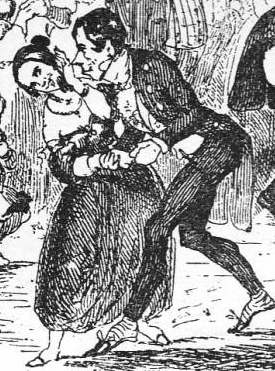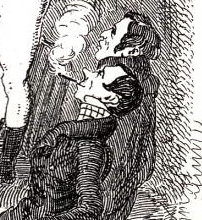

Mr. Snodgrass by J. Clayton Clarke ("Kyd") for the watercolour series (1910): reproduced on John Player cigarette card no. 10: Ninety-two Characters from Dickens: The Pickwick Papers. 2 ½ inches high by 1 ¼ inches wide (6.3 cm high by 3.3 cm wide). [Click on the images to enlarge them.]
MR. SNODGRASS (The Pickwick Papers)
One of the Pickwickians — a shadowy, colourless creature with a rapt expression and (presumably) a "strong poetic turn." It was Mr. Snodgrass who — upon the occasion of the free fight that followed the arrest of Mr. Pickwick at Ipswich — "in a truly Christian spirit and in order that he might take no one unawares, took off his coat with much deliberation announced in a very loud tone that he was about to begin." [Verso of Card No. 10]
Passage Illustrated: Introducing Augustus Snodgrass, One of Pickwick's Inner Circle
On the left of his great leader sat the poetic Snodgrass, and near him again the sporting Winkle; the former poetically enveloped in a mysterious blue cloak with a canine-skin collar, and the latter communicating additional lustre to a new green shooting-coat, plaid neckerchief, and closely-fitted drabs. [Chapter I of The Household Edition, "The Pickwickians," 2]
Commentary: The Poet Who Does Not Actually Write Anything

Left: Thomas Nast's 1873 rendition of Snodgrass as a poet, trying in vain to compose anything worthwhile after his marriage and settling down with Emily Wardle at Dingley Dell, Mr. Snodgrass (Ch. 57, American Household Edition).
Since Dickens's first novel is hardly a standard title on the secondary curriculum in most English-speaking countries, the ridiculous Augustus Snodgrass is no longer a byword for blustering cowardice or poetic posturing. The illustration leaves viewers in a quandary, for the passage quoted on the verso, Snodgrass's challenge to all-comers at Ipswich, has nothing to do with his striking a Romantic pose befitting an aspiring poet of the Keatsian variety. Dickens introduces him as "Augustus Snodgrass, Esqu., MPC" [i.e., "Member of the Pickwick Club"] at the Pickwickians' banquet which opens the April 1836 (initial monthly) instalment. In the second chapter, he strikes such a pose as he listens to Jingle's fabricated tale of romance with Donna Christina. The blue cloak that Snodgrass grips appears again in Chapter 15, in which he wears blue satin trunks and matching cloak. However, Snodgrass's doffing his coat in preparation for a fist-fight suggests the following passage later in the novel:



Right: Nast's earliest rendering of August Snodgrass, detail from And addressed the Club himself had founded (Chapter One). Centre: Phiz's thumbnail of Snodgrass dancing with Emily Wardle, in the Christmas Eve at Mr. Wardle's (January 1837). Left: Seymour's original conception of Snodgrass, left of Pickwick, with Winkle in the foreground: Mr. Pickwick Addresses the Club (April 1836).
Whether Mr. Winkle was seized with a temporary attack of that species of insanity which originates in a sense of injury, or animated by this display of Mr. Weller's valour, is uncertain; but certain it is, that he no sooner saw Mr. Grummer fall than he made a terrific onslaught on a small boy who stood next him; whereupon Mr. Snodgrass, in a truly Christian spirit, and in order that he might take no one unawares, announced in a very loud tone that he was going to begin, and proceeded to take off his coat with the utmost deliberation. He was immediately surrounded and secured; and it is but common justice both to him and Mr. Winkle to say, that they did not make the slightest attempt to rescue either themselves or Mr. Weller; who, after a most vigorous resistance, was overpowered by numbers and taken prisoner. The procession then reformed; the chairmen resumed their stations; and the march was re-commenced. [Chapter XXIV of The Household Edition, "Wherein Mr. Peter Magnus grows Jealous, and the Middle-aged Lady Apprehensive, which Brings the Pickwickians within the Grasp of the Law," 168]
Relevant Scenes of the Ipswich Conflict from Phiz's 1836 and 1874 Series


Left: Phiz's revision of the street brawl at Ipswich for the Household Edition: A compliment which Mr. Weller returned by knocking him down out of hand: having previously, with the utmost consideration, knocked down a chairman for him to lie upon (Chapter XXIV). Centre: Sol Eytinge, Jr.'s portrait of the egocentric law clerk: Mr. Chuckster (1867). Right: Phiz's serial realisation of Sam's intervening to rescue Pickwick, Winkle, and Snodgrass: Mr. Weller Attacks the Executive of Ipswich (December 1836, Ch. 24).
Other artists who illustrated this work, 1836-1910
- Robert Seymour (1836)
- Thomas Onwhyn (1837)
- Felix Octavius Carr Darley (1861)
- Sol Eytinge, Jr. (1867)
- Thomas Nast (1873)
- Harry Furniss (1910)
Scanned images and text by Philip V. Allingham. [You may use these images without prior permission for any scholarly or educational purpose as long as you (1) credit the person who scanned them and (2) link your document to this URL in a web document or cite the Victorian Web in a print one.]
Bibliography
The Characters of Charles Dickens pourtrayed in a series of original watercolours by “Kyd.” Lonodn, Paris, and New York: Raphael Tuck & Sons, nd. [1910?]
Davis, Paul. Charles Dickens A to Z: The Essential Reference to His Life and Work. New York: Facts On File, 1998.
Dickens, Charles. The Posthumous Papers of the Pickwick Club. Illustrated by Robert Seymour, R. W. Buss, and Hablot Knight Browne ('Phiz'). London: Chapman & Hall: April 1836 through November 1837.
_______. Posthumous Papers of the Pickwick Club. Frontispieces by Felix Octavius Carr Darley and Sir John Gilbert. The Household Edition. 55 vols. New York: Sheldon & Co., 1863. 4 vols.
_______. Posthumous Papers of the Pickwick Club. Illustrated by Sol Eytinge, Jr. The Diamond Edition. 14 vols. Boston: Ticknor & Fields, 1867. Vol. 1.
_______. Posthumous Papers of the Pickwick Club. Illustrated by Thomas Nast. The Household Edition. 22 vols. New York: Harper and Brothers, 1873. Vol. 2.
_______. Posthumous Papers of the Pickwick Club. Illustrated by Hablot Knight Browne ('Phiz'). The Household Edition. 22 vols. London: Chapman and Hall, 1874. Vol. 5.
_______. Posthumous Papers of the Pickwick Club. Illustrated by Thomas Nast. The Household Edition. 16 vols. New York: Harper and Brothers, 1873. Vol. 4.
_______. Posthumous Papers of the Pickwick Club. Illustrated by Harry Furniss. The Charles Dickens Library Edition. 18 vols. London: Educational Book, 1910. Vol. 2.
Created 6 January 2015
Last updated 11 July 2025